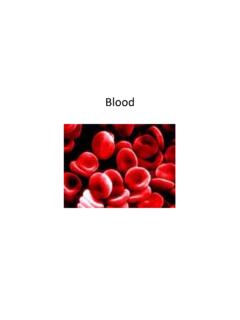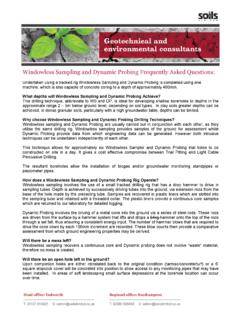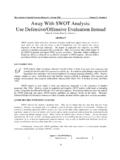Transcription of MULTIPLE CHOICE QUESTIONS: OPHTHALMOLOGY (FOR …
1 MULTIPLE CHOICE QUESTIONS: OPHTHALMOLOGY (FOR MBBS FINAL PART I) EYELIDS, CONJUNCTIVA, CORNEA AND SCLERA is: a. Misdirected eyelashes b. Accessory row of eyelashes c. Downward drooping of upper lid d. Outward protrusion of lower lid ANSWER: B 2. Band shaped keratopathy is commonly caused by deposition of: a. Magnesium salt b. Calcium salt c. Ferrous salt d. Copper salt ANSWER: B 3. Irrespective of the etiology of a corneal ulcer, the drug always indicated is: a. Corticosteroids b. Cycloplegics c. Antibiotics d. Antifungals ANSWER: B 4. Dense scar of cornea with incarceration of iris is known as: a. Adherent Leucoma b. Dense leucoma c.
2 Ciliary staphyloma d. Iris bombe ANSWER: A 5. Corneal sensations are diminished in: a. Herpes simplex b. Conjunctivitis c. Fungal infections d. Marginal keratitis ANSWER: A 6. The color of fluorescein staining in corneal ulcer is: a. Yellow b. Blue c. Green d. Royal blue ANSWER: C 7. Phlycten is due to: a. Endogenous allergy b. Exogenous allergy c. Degeneration d. None of the above ANSWER: A 8. A recurrent bilateral conjunctivitis occurring with the onset of hot weather in young boys with symptoms of burning, itching, and lacrimation with large flat topped cobble stone papillae raised areas in the palpebral conjunctiva is: A. Trachoma B.
3 Phlyctenular conjunctivitis C. Mucopurulent conjunctivitis D. Vernal keratoconjunctivitis ANSWER: D 9. Which of the following organism can penetrate intact corneal epithelium? A. Strept pyogenes B. Staph aureus C. Pseudomonas pyocyanaea D. Corynebacterium diphtheriae ANSWER: D 10. A 12 years old boy receiving long term treatment for spring catarrh, developed defective vision in both eyes. The likely cause is: a. Posterior subcapsular cataract b. Retinopathy of prematurity c. Optic neuritis d. Vitreous hemorrhage ANSWER: A 11. A young child suffering from fever and sore throat began to complain of lacrimation. On examination, follicles were found in the lower palpebral conjunctiva with tender preauricular lymph nodes.
4 The most probable diagnosis is: a. Trachoma b. Staphylococal conjunctivitis c. Adenoviral conjunctivitis d. Phlyctenular conjunctivitis ANSWER: C 12. Patching of the eye is contraindicated in: a. Corneal abrasion b. Bacterial corneal ulcer c. Mucopurulent conjunctivitis d. After glaucoma surgery ANSWER: C 13. Ten years old boy complains of itching. On examination, there are mucoid nodules with smooth rounded surface on the limbus, and mucous white ropy mucopurulent conjunctival discharge. He most probably suffers from: a. Trachoma b. Mucopurulent conjunctivitis c. Bulbar spring catarrh d. Purulent conjunctivitis ANSWER: C 14.
5 In viral epidemic kerato-conjunctlvitis characteristically there is usually: a. Copious purulent discharge b. Copious muco-purulent discharge c. Excessive watery lacrimation d. Mucoid ropy white discharge ANSWER: C 15. Corneal Herbert's rosettes are found in: a. Mucopurulent conjunctivitis b. Phlyctenular keratoconjunctivitis c. Active trachoma d. Spring catarrh ANSWER: C 16. A patient complains of maceration of skin of the lids and conjunctiva redness at the inner and outer canthi. Conjunctival swab is expected to show: a. Slaphylococcus aureus. b. Streptococcus viridans. c. Streptococcus pneumonae d. Morax- Axenfeld diplobacilli ANSWER: D 17.
6 Tranta's spots are noticed in cases of: a. Active trachoma b. Bulbar spring catarrh c. Corneal phlycten d. Vitamin A deficiency ANSWER: B 18. A painful, tender, non itchy localized redness of the conjunctiva can be due to: a. Bulbar spring catarrh. b. Episcleritis. c. Vascular pterygium. d. Phlyctenular conjunctivitis. ANSWER: B 19. In trachoma the patient is infectious when there is: a. Arlt's line b. Herbert's pits c. Post-trachomatous concretions. d. Follicles and papillae in the palpebral conjunctiva. ANSWER: D 20. A female patient 18 years old, who is contact lens wearer since two years, is complaining of redness, lacrimation and foreign body sensation of both eyes.
7 On examination, visual acuity was 6/6 with negative fluorescein test. The expected diagnosis can be: a. Acute anterior uveitis. b. Giant papillary conjunctivitis. c. Bacterial corneal ulcer. d. Acute congestive glaucoma ANSWER: B 21. Fifth nerve palsy could cause: a. Ptosis b. Proptosis c. Neuropathic keratopathy d. Lagophthalmos ANSWER: C 22. Topical steroids are contraindicated in a case of viral corneal ulcer for fear of: a. Secondary glaucoma b. Cortical cataract. c. Corneal perforation d. Secondary viral infection. ANSWER: C 23. The sure diagnostic sign of corneal ulcer is a. Ciliary injection b. Blepharospasm c. Miosis d. Positive fluorescein test.
8 ANSWER: D 24. The effective treatment of dendritic ulcer of the cornea is: a. Surface anesthesia b. Local corticosteroids c. Systemic corticosteroids d. Acyclovir ointment ANSWER: D 25. Herpes simplex keratitis is characterized by: a. Presence of pus in the anterior chamber b. No tendency to recurrence c. Corneal hyposthesia d. Tendency to perforate ANSWER: C 26. Bacteria, which can attack normal corneal epithelium: a. Neisseria gonorrhea. b. Staphylococcal epidermidis c. Moraxella lacunata. d. Staphylococcal aureus ANSWER: A 27. Advanced keratoconus is least to be corrected when treated by: a. Hard contact Lens, b. Rigid gas permeable (RGP) contact lens c.
9 Spectacles. d. Keratoplasty. ANSWER: C 28. Organisms causing angular conjunctivitis are: a. Moraxella Axenfeld bacilli b. Pneumococci c. Gonococci d. Adenovirus ANSWER: A 29. Chalazion is a chronic inflammatory granuloma of a. Meibomian gland b. Zies s gland c. Sweat gland d. Wolfring s gland ANSWER: A 30. Deep leucoma is best treated by: A. Tattooing B. Lamellar keratoplasty C. Keratectomy D. Penetrating keratoplasty ANSWER: D 31. Blood vessels in a trachomatous pannus lie: a. Beneath the Descemet's membrane. b. In the substantia propria. c. Between Bowman's membrane & substantia propria. d. Between Bowman's membrane & Epithelium.
10 ANSWER: D 32. In vernal catarrh, the characteristic cells are: a. Macrophage b. Eosinophils c. Neutrophils d. Epitheloid cells ANSWER: B 33. Ptosis in Horner's syndrome, is due to paralysis of: a. Riolan's muscle b. Horner's muscle c. Muller's muscle d. The levator palpebral muscle e. Orbicularis oculi muscle ANSWER: C 34. Severe congenital ptosis with no levator function can be treated by: A. Levator resection from skin side B. Levator resection from conjunctival side C. Fascia lata sling operation D. Fasanella servat operation ANSWER: C 35. The commonest cause of hypopyon corneal ulcer is: a. Moraxella b. Gonococcus c. Pneumococcus d.

















